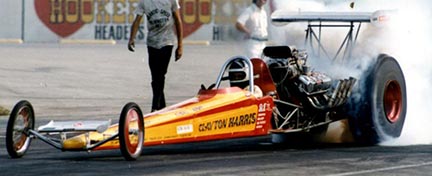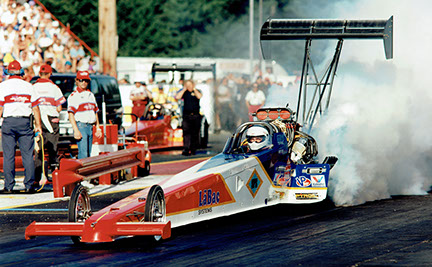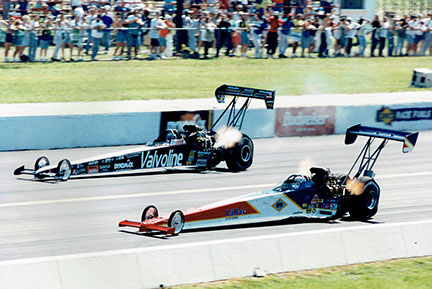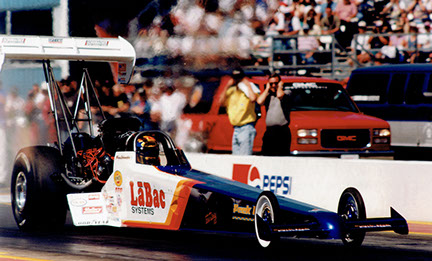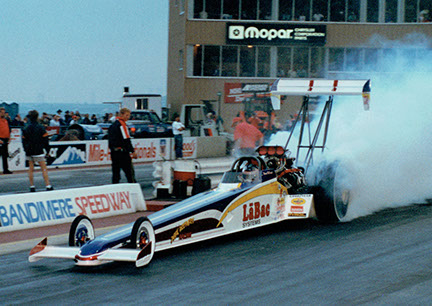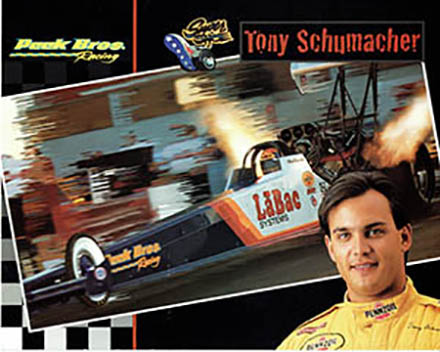Peek Brothers Racing
and
Peek Brothers Race Cars

Our involvement actually goes back to 1973 when Peek Brothers built it's first dragster for Clayton Harris and Marc Danakas. It debuted at the Columbus Spring Nationals where it received the best engineered car award. This car won the following Summer Nationals in English Town. We built a total of three cars for Clayton between '73 and '76. He was a very clever and innovative individual, forcing me to learn and figure out how to meet his wishes, even if NHRA would go on to change the rules outlawing what we had done.
In 1992 we got back together with Clayton, moving him to Denver to start Safety and Performance Systems. SPS was to be a company which would capitalize on his idea to design and build racing related products with the intent of providing financial stability to his life. A top fuel car certainly was not part of that plan as far as Michael and I were concerned....but became necessary to "test" his inventions. At the Mile High Nationals things didn't work out well with what was the first side by side top fuel fires.
We, as owners of LaBac Systems continued racing with Clayton for a few more years, doing some interesting, fun and worthwhile product development. A lot of that work was in preventing "Blow Over's" which were a common occurance in the '90's. We developed a system which would shut the ingine down if the front wheels got "X feet" off the ground. This was tested on our car as well as Gene Snow's car.
A couple of other innovations which actually went into production and have survived to this day were a killer valve spring compressor and a T-Handle spark plug preset torque wrench. Both of these products were given to our friend Mike Troxel (Alcahol dragster and MTI fame).
The final contraption that Clayton dreamed up was a pneumatic clutch. Clayton, Michael and I designed the mechanical aspect of the clutch and Clayton did the control system. Mechanically we made it work well and a couple of units were tested by Garlits and Jim Head. Functionally the pressure plate worked great but the pneumatic control system was Clayton's baby and nobody else knew what to do with if and even Clayton had a difficult time getting it to do the same thing two consecutive runs.
The lack of consistency was probably the unwinding of our relationship with Clayton, we parted company in '94 or '95. Later I developed a control design which used a micro processor and would allow you to monitor several sensors and the computer would make adjustments within the preset limits. I attempted to get NHRA to allow us to continue development of it based on the ability to eliminate tire smoke and sell live TV. They would not go for it and we still don't have live TV coverage of NHRA national events.
We continued racing, ultimately running the entire NHRA schedule until 2000. We had a few people drive for us, Rance McDaniel drove until the car finally went 300 at Somoma when it destroyed the rear tires and took out the wing. He didn't like that. We had some one shot drivers, Pat Dakin and Gary Beck before hiring a young rookie, Tony Schumacher. Tony was hired without having driven anything like it, because we thought he was a marketable person. History has proven that to ge a correct decision, we just never got to the right prospective sponsors before Tony's dad, Don Schumacher put together a deal we could not compete with and gradually brought the operation to a halt in 2002.
For several years it was a lot of exciting fun, a lot of work, a lot of investment and short on rewards. Michael and I don't regret having done it but wouldn't do it again!
